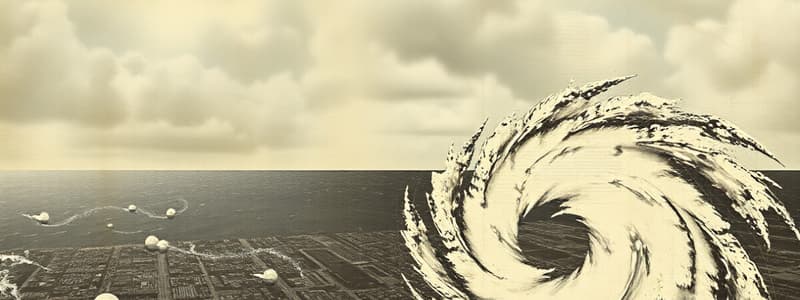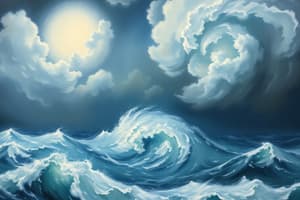Podcast
Questions and Answers
What is the name given to a tropical cyclone in China and Japan?
What is the name given to a tropical cyclone in China and Japan?
- Cyclone
- Hurricane
- Willy-Willy
- Typhoon (correct)
What is the direction of wind rotation in a tropical cyclone in the Southern Hemisphere?
What is the direction of wind rotation in a tropical cyclone in the Southern Hemisphere?
- Depends on the specific cyclone
- Counter-clockwise
- Variable
- Clockwise (correct)
What is the lowest temperature required for the formation of a tropical cyclone?
What is the lowest temperature required for the formation of a tropical cyclone?
- 27°C (correct)
- 20°C
- 25°C
- 30°C
What is the defining feature of a tropical cyclone?
What is the defining feature of a tropical cyclone?
What is the role of the Coriolis effect in the formation of a tropical cyclone?
What is the role of the Coriolis effect in the formation of a tropical cyclone?
Flashcards
Tropical Cyclone
Tropical Cyclone
A low-pressure system forming in the tropics with thunderstorms and a circular wind pattern.
Coriolis Effect
Coriolis Effect
The deflection of moving objects to the right in the Northern Hemisphere and to the left in the Southern Hemisphere due to Earth's rotation.
Temperature Requirement
Temperature Requirement
Tropical cyclones need sea surface temperatures of 27°C or higher to develop.
Naming of Cyclones
Naming of Cyclones
Signup and view all the flashcards
Cross-section Features
Cross-section Features
Signup and view all the flashcards
Study Notes
Tropical Cyclones
- Tropical cyclones are low-pressure systems forming in the tropics (5°C to 30°C North and South).
- They are associated with thunderstorms and circulating winds near the Earth's surface.
- Winds rotate clockwise in the Southern Hemisphere and counter-clockwise in the Northern Hemisphere.
- Synonymous terms include hurricanes (Americas), typhoons (China/Japan), and willy-willies (Australia).
- Cyclones are named alphabetically within the season they occur. Example: "Alfred" is the first cyclone of the season.
Characteristics of Tropical Cyclones
- For a tropical cyclone to form, specific conditions are required:
- Temperature of 27°C or more
- Coriolis force
- Sufficient moisture
- Active atmospheric circulation
Cyclone Structure
- Figure 1.2.2A depicts a cross-section through a mature tropical cyclone.
- The image displays key components:
- Subsiding air
- Eye
- Low pressure
- Cumulonimbus clouds
- Cumulus clouds
- Thunderstorms
- The figure is correlated to a synoptic view in Figure 1.2.3B.
Studying That Suits You
Use AI to generate personalized quizzes and flashcards to suit your learning preferences.




